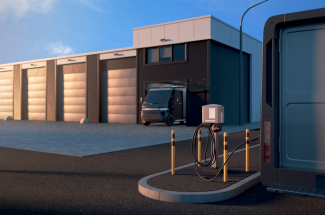Rising fuel prices and concern with the global impact of fossil fuels are resulting in rapid growth in the adoption of electric vehicles (EVs). Building out the required infrastructure to support this scale of demand is needed, and governments and utility companies are offering subsidies to businesses and consumers to encourage that.
Public EV charging
Charging at home remains the preferred option for most EV drivers, but the availability of public infrastructure for charging is critical for mass adoption. Among the different location possibilities for public charging, workplace charging, and multi-unit residential charging are each set to comprise of 17% of the entire market. Providing safe and reliable charging options in these locations ensures higher satisfaction among employees or tenants and can lead to long-term retention. It is also a fantastic way to differentiate the company or property from competitors.
Another rapidly growing category of companies that are investing in on-site EV charging is those who own fleet vehicles. Companies are rapidly switching to electric vehicles across the spectrum of light-, medium-, and heavy-duty trucks and are looking to build robust EV charging infrastructure to support efficient operations. Depot charging remains the most preferable option due to the lower cost of installation and operation, and the flexibility to charge vehicles based on driving schedules.
Enphase CS-100: High power Level 2 charging with advanced capabilities
Enphase is launching an upgraded version of its most powerful EV charging station, the CS-100, in line with changing market demands. With a continuous power of 19.2 kW, the charger is perfect for fleet vehicles that can accept the maximum power of a Level 2 charger, such as the Ford F150 Lightning, Chevy Silverado, SEA Electric, as well as electric buses like BYD and Blue Bird.
Some CS-100 highlights:
| Power rating | • 19.2 kW • 80 A, 208/240 V, Level 2 |
| Safety considerations | • UL Listed • NEMA 3R-rated enclosure, suitable for outdoor use |
| Warranty | • 3-year |
| Cable characteristics | • 25-foot ruggedized cable • Integrated cable management |
| Smart features | • Enables external load management (4 power levels: 0%, 25%, 50%, 100%) to control energy usage and prevent overload at peak times • Enables external access control through the ChargeGuard EX interface to ensure access only to approved users • Intelligent load sharing with another CS-100 installed on the same circuit • Remote monitoring and control of the charging station |
| Key differentiator | • No network fees are required to enable the above-mentioned smart features |

The CS-100 has our proprietary COSMOS interface that can integrate with external building energy management and access control systems, which provides additional benefits. Whether charging needs to be restricted to authorized users or the property manager merely wants to optimize the utility bill, the CS-100 enables the required controls.
Installation considerations
The CS-100 can be custom-activated to suit site-specific requirements. Enphase product experts can help determine the specific charging needs based on considerations like EV capacity, charging frequency, parking lot layout, and existing electrical infrastructure. They can also recommend accessories that might be needed, such as pedestal mounts or cable retractors.
Rebates and incentives
Charging stations qualify for a wide range of EV-related rebates and tax credits depending on the location, utility provider, and purpose of installation. The incentives can help completely or partially offset the cost of purchase and installation of EV charging stations, enhancing the financial appeal of fleet electrification. The Alternative Fuels Data Center (AFDC) website keeps a searchable database of incentives. Some of the rebates and tax credits at the time of publication include:
• Alternative Fuel Infrastructure Tax Credit (AFITC) up to $100,000 for commercial EV chargers
• Additional state and utility-sponsored incentives (e.g., LADWP, Consumers Energy)
• IIJA provides incentives for electric bus fleets operated by EPA and FTA
What does the future hold for commercial EV charging?
Enhancements in commercial EV charging will include providing more control and simplifying the experience for users. These enhancements are possible through technologies such as OCPP and API integrations and will include tracking and reporting usage data which can help fleet owners reduce overall operating expenses without compromising on quality, power, or safety.


